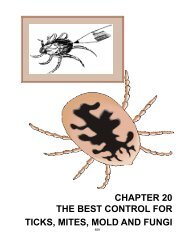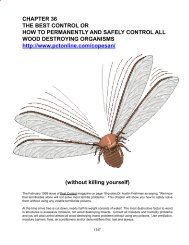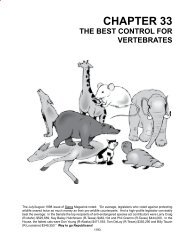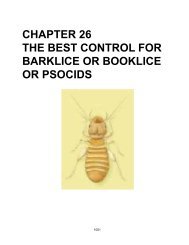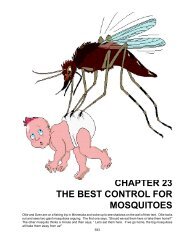chapter 16 the best control for human lice and scabies
chapter 16 the best control for human lice and scabies
chapter 16 the best control for human lice and scabies
You also want an ePaper? Increase the reach of your titles
YUMPU automatically turns print PDFs into web optimized ePapers that Google loves.
Many glycol e<strong>the</strong>r compounds have dangerous <strong>human</strong> reproductive effects. Questionable carcinogen with<br />
experimental tumorigenic data. Mutation data reported. Combustible when exposed to heat or flame; can react<br />
with oxidizing materials” SAXS also noted, “Pyrethrins Safety Profile: Moderately toxic to <strong>human</strong>s by ingestion.<br />
Poison experimentally by ingestion, intraperitoneal <strong>and</strong> intravenous route. Experimental reproductive effects...can<br />
cause gastrointestinal, respiratory <strong>and</strong> central nervous system effects. A dose of 15 grams (only a little more than<br />
½ ounce) has caused <strong>the</strong> death of a child. Chronic exposures can cause liver damage.” A 37-year old woman<br />
developed severe shortness of breath five minutes after beginning to wash her family dog with D-Flea ® insecticide<br />
shampoo containing pyrethrin. Her death shortly after her arrival at <strong>the</strong> nearest hospital was attributed to sudden,<br />
irreversible, bronchial spasm from exposure to <strong>the</strong> pyrethrin shampoo. According to a report by Paul M. Wax<br />
of Rochester, New York - Clinical toxicology (32:4, 1994) - NPA noted that while this report was not associated<br />
with head <strong>lice</strong>, <strong>the</strong> NPA has had reports that are using pet (poison) shampoos on children - because of all <strong>the</strong><br />
“treatment” failures <strong>the</strong>y have been having with commercially available <strong>lice</strong> treatments/poisons. If you think<br />
<strong>the</strong> Raid example was bad, I noticed an advertisment from FMC ® in <strong>the</strong> May 1998 Service Technician/PCT that<br />
proudly proclaims <strong>the</strong> termiticide (poison) <strong>the</strong>y sell to use against termites is <strong>the</strong> same active poison ingredient<br />
used as a <strong>lice</strong> shampoo <strong>for</strong> children! Then FMC ® notes that in soil degradation studies conducted all acoss <strong>the</strong><br />
country this termiticide poison (permethrin) has been shown to be <strong>the</strong> longest lasting soil poison! - Implying that<br />
if your children get <strong>lice</strong> you can simply have <strong>the</strong> termite man spray <strong>the</strong>ir heads with <strong>the</strong> longest-lasting soil poison<br />
on <strong>the</strong> market today! Amazing! Many thous<strong>and</strong>s of people have safely gotten <strong>control</strong> of resistant head <strong>lice</strong><br />
<strong>and</strong> nits with Lice R Gone ® Enzyme Shampoo <strong>and</strong> Nit Remover <strong>and</strong> Tangles R Gone ® Hair Condtioner.<br />
“Our” Environmental Protection Agency (EPA) is not expected to make a decision on <strong>the</strong> re-registration of PBO<br />
until at least 1996. “Our” Food <strong>and</strong> Drug Administration (FDA) still maintains that lindane products are “safe<br />
<strong>and</strong> effective when used as directed!” This in spite of all of <strong>the</strong> contrary health evidence <strong>and</strong> <strong>the</strong> federal law that<br />
clearly states it is illegal to say any pesticide poison is “safe”. On March <strong>16</strong>, 1994, “our” EPA stated that lindane<br />
will remain on <strong>the</strong> market while it (slowly) compiles more health data on its risks. Note: way back in 1977,<br />
EPA initiated a special review of lindane due to all of <strong>the</strong> known <strong>and</strong> suspected health problems <strong>and</strong> negative<br />
environmental effects <strong>the</strong>n — yet no serious action has yet been taken. Prescription lindane <strong>lice</strong> <strong>and</strong> <strong>scabies</strong><br />
poisons are still being used on children by family members <strong>and</strong> in hospitals, schools <strong>and</strong> o<strong>the</strong>r institutions.<br />
Lindane is also still being used to treat Christmas trees, agricultural seeds, livestock, pecans, logs <strong>and</strong> lumber,<br />
ornamentals, <strong>for</strong>est trees, pets, households <strong>and</strong> o<strong>the</strong>r buildings <strong>and</strong> assorted fruits <strong>and</strong> vegetables! Bon appetit!<br />
Propylene glycol is used as an “inert” in many over-<strong>the</strong>-counter shampoos. The Spectrum ® Material Safety Data<br />
Sheet notes propylene glycol’s potential acute health effects as: very dangerous in case of ingestion. Slightly<br />
dangerous to dangerous to dangerous in case of skin contact (irritant), of eye contact (irritant), of inhalation.<br />
Very slightly to slightly dangerous in case of skin contact (permeator). This product may irritate eyes <strong>and</strong> skin<br />
upon contract.<br />
If you have used pediculide or scabicide poisons in <strong>the</strong> past, we suggest you use Not Nice to Toxins ®<br />
<strong>and</strong> Safe Solutions Food-grade DE to help detox your body.<br />
Intelligent Pest Management ®<br />
Lice - Typical First Strikes by Housekeeping & Maintenance<br />
1. Thoroughly vacuum each room daily wherever <strong>lice</strong> have been a problem <strong>and</strong> spray carpets <strong>and</strong> floors<br />
with Not Nice to Bugs<br />
804<br />
® or 1 oz. of Safe Solutions Enzyme Cleaner with Peppermint (per quart of water)<br />
or mop floors with 1 oz. Safe Solutions, Inc. enzyme cleaners <strong>and</strong> borax. If you must spray, spray furni<br />
ture <strong>and</strong> bedding with Not Nice to Bugs ® .<br />
2. Give parents <strong>and</strong> teachers a copy of this entire <strong>chapter</strong> on Lice.<br />
3. Give whoever asks 2 packets or an 8 oz. bottle of Lice R Gone ® Shampoo <strong>for</strong> each child <strong>and</strong> this <strong>chapter</strong>.<br />
This non-poisonous shampoo makes <strong>the</strong> hair so slick <strong>the</strong>y can’t stick <strong>and</strong> <strong>lice</strong> can not live off <strong>the</strong> body<br />
<strong>for</strong> very long. You only need to give 1 bottle of Lice R Gone ® to treat an entire family. (Only ½ oz. of Lice<br />
R Gone ® will remove <strong>the</strong> <strong>lice</strong> <strong>and</strong> nits on a long-haired person in 5 - 10 minutes.) If you have been using<br />
o<strong>the</strong>r pediculicides, this “treatment” may have literally welded <strong>the</strong> nits to <strong>the</strong> hair shaft <strong>and</strong> it<br />
may take several more minutes <strong>and</strong>/or shampoos <strong>and</strong>/or Tangles R Gone ® Hair Conditioner to re<br />
move <strong>the</strong>se treated nits. A simple hair dryer will kill <strong>lice</strong>, especially if you use a shower cap.<br />
4. Assign each child his/her own locker or hook.<br />
5. For stubborn cases, wash each family member’s hair once a week <strong>for</strong> 3 weeks with Lice R Gone.



